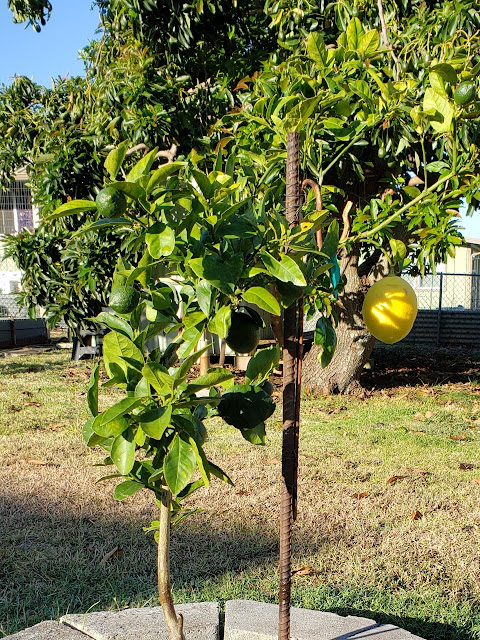Dean and Katrina live in Pukalani but have a Makawao postal address. This area is in what is called Maui Upcountry where there are many ranches and farms. Elevation of their house is a little over 1600 feet. Pukalani means "Window of Heaven" in Hawaiian and Makawao means "Eye of the Forest." Elevations throughout Upcountry (depending on who you ask) range from around 1000 to over 3000 feet.
The higher elevation means that more fruit trees and vegetables grow well here. In their yard there are some old, established trees along with some newer ones that Dean has recently planted.
Here's a pic of their avocado tree. The fruits will start to ripen later in the summer and are reputed to be the best in the area. As with many fruits and vegetables, there are many varieties of avocado that are very tasty but don't make it to our stores. Here's a link to a guide to the fifty most popular varieties, if you're interested: https://www.finedininglovers.com/article/how-many-avocado-varieties-do-you-know-here-are-over-50
These avocadoes will be ready to pick beginning in October.
Their Macadamia tree is another well-established tree.

The tree is loaded with growing nuts that will mature later in the year. What you see is the outer husk. When the nuts are almost ripe they fall from the tree, finish ripening and then the husk splits, leaving the hard-shelled nut.

Here's one type of Macadamia nut cracker. The base is a piece of heavy hardwood holding a heavy steel plate and there is a hole to hold the handle part when it's not being used. The handle is another heavy piece of hardwood with a hard rubber holder for the nut and a specially shaped piece of heavy wire that extends from the base of the rubber, through the handle and pops up when the nut is inserted. To use, you insert the nut, strike it forcefully on the steel plate, eject the cracked (hopefully) nut and separate the cracked shell from the nut. In this photo you see uncracked nuts at top, nuts in their husks in the middle and the cracked nuts at bottom. There is one nut in the rubber holder ready to be cracked. As you can see, the holder is partially split so it can hold various sized nuts.
A new banana tree setting its first bunch of fruit.
Dean planted these trees about a year ago. They are Apple Bananas, a popular variety here in Maui Upcountry. They are shorter than the typical bananas we get in supermarkets on the Mainland, but they are rich and sweet.
There were a couple of papayas on the property when they bought it. These are new trees he planted and are bearing fruit already.
A lemon tree doing its thing. The blocks around the base keep away the wild chickens who love to scratch in the fresh dirt around his plantings.
I haven't tried to count the chickens that come through their yard but there must be four or five roosters and twice as many hens. I've seen hens with 10 young chicks but as the chicks grow, natural attrition takes some so hens with larger chicks still following her have families of one to four or five chicks, the rest being lost to predation, accident and neglect.
Papayas in the foreground, next bananas with the Macadamia tree in the background.
Tomatoes grow well here. These are very tasty.
Couldn't resist taking a shot of the waning gibbous moon through the papaya.
These fruits are, in the bowl, ripe apple bananas, green bananas, two local grapefruits from the farmer's market and a lemon from Dean's tree. On the right are two varieties of avocado from the farmer's market and a couple of limes that the fisherman gave us when we bought a small (20#) Ahi tuna yesterday at a pop-up roadside stand. The tuna was freshly caught so we had sashimi and spicy tuna temaki for dinner last night.
Temperatures this time of year, in this area, run in the low sixties to the mid-eighties, although the current temperature right here is 89 degrees at 1320. Today is an unusually warm day for this time of year because there is little wind and warm sun. I must say it feels good in my arthritic joints.
Tomorrow I'll post some of the local flowers.











































